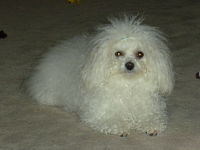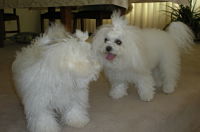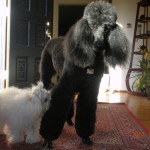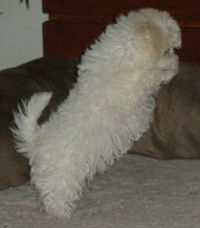History
 Bolognese is a member of the Bichon family, which includes the Bichon Frise, Maltese, Lowchen, Havanese, and Coton de Tulear.
Bolognese is a member of the Bichon family, which includes the Bichon Frise, Maltese, Lowchen, Havanese, and Coton de Tulear.
 The Bolognese are named after Bologna, a city in northern Italy, thought to be the place of their conception and its existence has been recorded since the 11th century in art and literature.
The Bolognese are named after Bologna, a city in northern Italy, thought to be the place of their conception and its existence has been recorded since the 11th century in art and literature.

 They can be seen in tapestry work produced by Flemish craftsmen dating as far back as the 17th century. Additionally, Bolognese are seen in paintings by Goya, Gosse, Watteau, among others. Additionally, the Venetian painter Titian painted the Duke Frederico Gonzaga with his Bolognese.
They can be seen in tapestry work produced by Flemish craftsmen dating as far back as the 17th century. Additionally, Bolognese are seen in paintings by Goya, Gosse, Watteau, among others. Additionally, the Venetian painter Titian painted the Duke Frederico Gonzaga with his Bolognese.
The breed was almost extinct by the end of World War II, but Italian breeders were able to restore the Bolognese to popularity again. As far as the breed in the U.S., the Bolognese Club of America was founded in 1986. The Bolognese was recognized by the United Kennel Club in 1995, and by the AKC Breed Group: Foundation Stock Service in 1999. Even so, Bolognese are still considered a very rare breed in the United States.
Appearance
 The Bolognese is a small, white, compact dog with a distinctive white single coat. It is of stocky, square build and well-muscled. Its eyes are well developed, open and round. The rims of the eyelids are black and the iris is a dark ochre color. The large muzzle and lips are black. The ears are set high and are long and hanging but rigid at the base. The tail is carried curved over the back.
The Bolognese is a small, white, compact dog with a distinctive white single coat. It is of stocky, square build and well-muscled. Its eyes are well developed, open and round. The rims of the eyelids are black and the iris is a dark ochre color. The large muzzle and lips are black. The ears are set high and are long and hanging but rigid at the base. The tail is carried curved over the back.
Weight: 4.5-9 lbs Height: Male: 10-11 Female: 9.8-11 inches
The Bolognese Breed Standard as recognized by the Federation Cynologique International (FCI).
Personality and Temperament
 Trademark traits of the Bolognese include: being very happy, playful, friendly, earnest, willing, intelligent, and creative. Bolognese are known for the bond they forms with their owners. They love curling up on their owner’s lap! Bolognese are playful but adapt to the owner’s lifestyle and activities, so they can adapt well to condos and apartment living. They will do fine without a yard but they do not like to be left alone for extended periods of time.
Trademark traits of the Bolognese include: being very happy, playful, friendly, earnest, willing, intelligent, and creative. Bolognese are known for the bond they forms with their owners. They love curling up on their owner’s lap! Bolognese are playful but adapt to the owner’s lifestyle and activities, so they can adapt well to condos and apartment living. They will do fine without a yard but they do not like to be left alone for extended periods of time.
 This small dog is friendly with strangers and is a cheerful companion. They bark to alert but are not a yappy breed. Also, they are good at socializing with other dogs, big and small.
This small dog is friendly with strangers and is a cheerful companion. They bark to alert but are not a yappy breed. Also, they are good at socializing with other dogs, big and small.
Bolognese are best suited to a home with elderly, retires, families with children who is old enough and mature enough to handle toy dogs gently, carefully, and safely.
Exercise
Bolognese do not require an excessive amount of exercise. They are perfectly happy to lounge around the house but enjoy a daily walk or free play in a small yard.A good walk would be around 20-25 minutes once or twice a week.
Training
 Bolognese are easy to train but are quick to bore with numerous repetitive drills. They thrive on variety, so it is best to change or expand activities to keep them happily engaged and thinking. They respond well to positive reinforcement, gentle training methods and consistency. They do not respond well to shouting or harshness. Training must be done with firmness, fairness, and consistency.
Bolognese are easy to train but are quick to bore with numerous repetitive drills. They thrive on variety, so it is best to change or expand activities to keep them happily engaged and thinking. They respond well to positive reinforcement, gentle training methods and consistency. They do not respond well to shouting or harshness. Training must be done with firmness, fairness, and consistency.
Life span
Bolognese are long-living. The average life span of the Bolognese is 12 to 14 years but they have been known to live up to 18 years. They are known to still act puppy-like at 10 years of age and are able to maintain aspects of youthfulness throughout their senior years.
Health
Bolognese are, as far as we know, typically a healthy breed and are not prone to any serious hereditary issues or major problems. Standard health care is usually only regular vaccinations and deworming.
However, patella luxation can be a problem in many toy breeds, so I conduct patella checks on all of my dogs and their offsprings. My vet confirms our Bolognese are free from patella luxation. Additionally, our Bolognese undergo veterinary ophthalmology tests for predisposition to cataracts and any other serious eye defects every year.
